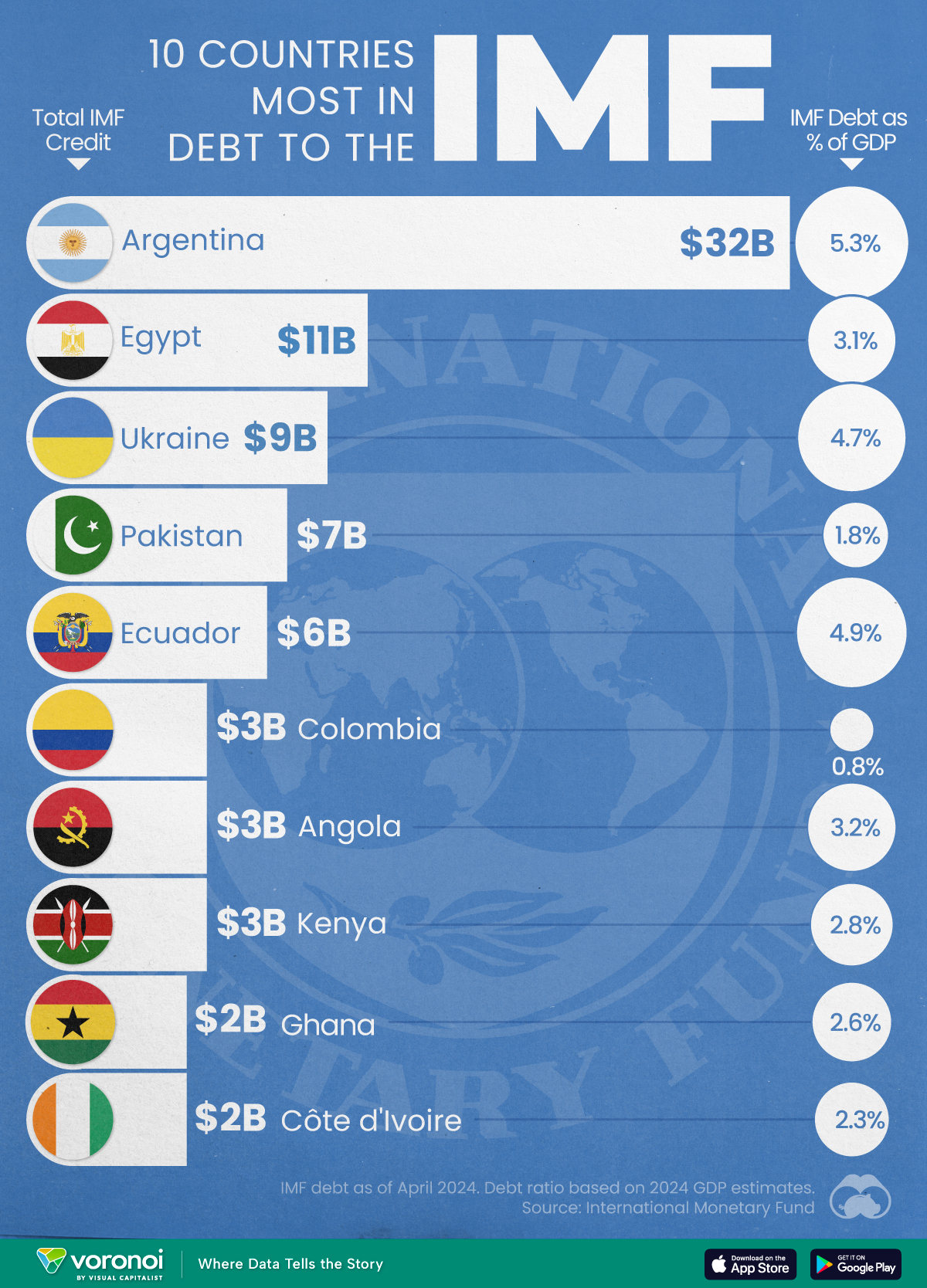Money
Prediction Consensus: What the Experts See Coming in 2024
This visual is part of our 2024 Global Forecast Series. For full access to the series, learn more here.
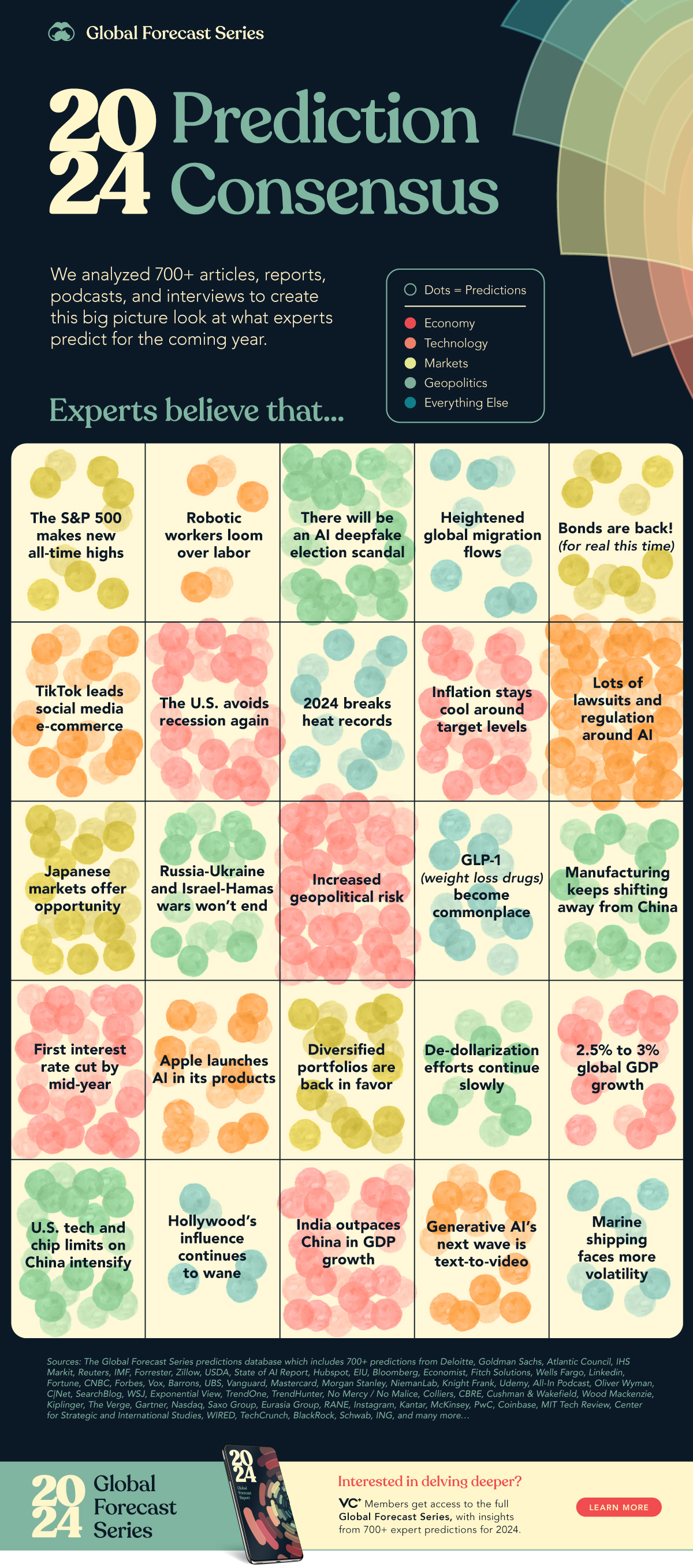
Prediction Consensus: What the Experts See Coming in 2024
As we look ahead to 2024, there is no shortage of expert forecasts and predictions for the world’s economy, markets, geopolitics, and technology to track in this new year.
In this now fifth year of our Prediction Consensus (part of our comprehensive 2024 Global Forecast Series), we’ve summarized 25 of the most common predictions and forecasts by experts into a single visual of what’s expected to happen in 2024.
Drawing from our predictions database of over 700 forecasts compiled from reports, interviews, podcasts, and more, the Prediction Consensus “bingo card” and this article offer an overview of the most cited trends and opportunities that experts are watching for the rest of the year.

The Economy and Markets in 2024
Based on the hundreds of economic forecasts and predictions we’ve sifted through, many analysts and experts share similar views on what’s ahead for inflation, interest rates, and economic growth in 2024.
Inflation: After inflation’s steady decline across economies in 2023, many analysts see inflation continuing to cool off towards target levels. While some note that the last stretch to these targets could be the toughest, few foresee the possibility of inflation surging again like we saw in 2022.
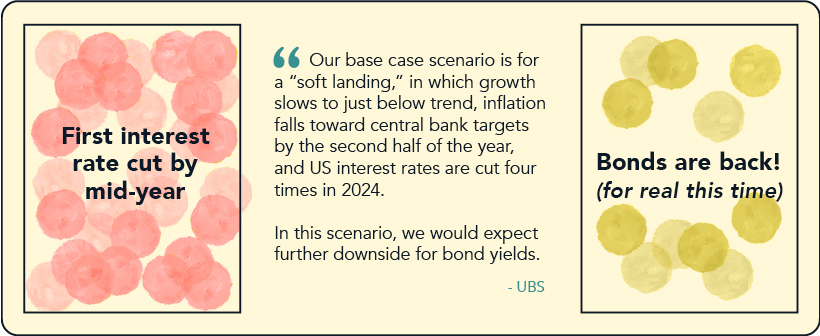
Interest Rates: With inflation largely expected to be tamed in 2024, every major bank and institution forecasts interest rate cuts by the Federal Reserve, European Central Bank, and Bank of England by the middle of the year. Forecasts from analysts on how much rates will be cut vary between three and six cuts, with Federal Reserve board members themselves forecasting two to three cuts.
Markets: With interest rate cuts on the horizon, experts have echoed tentatively positive forecasts for both stocks and bonds in 2024. Falling rates should see bond yields fall as well, while equities should continue to benefit from the growing AI theme. Portfolio diversification is a common theme in the 2024 investment playbook, especially as geopolitical risks loom.
Real GDP Growth: The outlook for growth around the world is muted. Global GDP growth forecasts range from 2.5-3%, which is slightly lower than the 10-year average (2013-2022) of 3.1%. The U.S. is also forecasted to see slowing growth, with the IMF’s forecasts of 2.4% in 2023 moving down to 1.5% in 2024, while Europe is also expected to continue seeing slow growth at 0.9% in 2024.
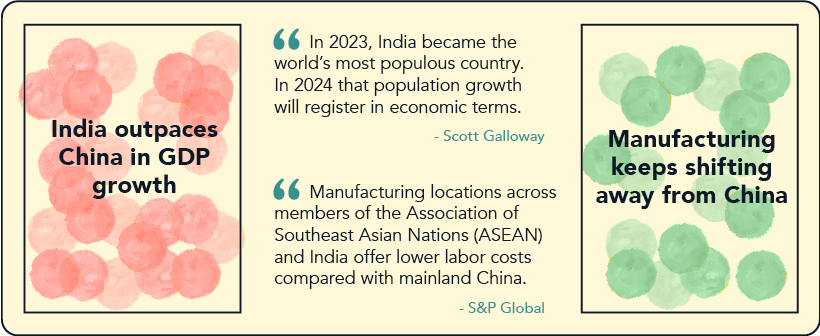
When looking at other nations, many experts are predicting we’ll see India outpace China when it comes to real GDP growth this year, especially if the trend of manufacturing and foreign investment shifting away from China continues.
“The transition is two-sided: India is investing in infrastructure and courting foreign investment, while China is investing in aircraft carriers and turning its gaze inward to deal with youth unemployment and sectors crashing.”
Geopolitical Predictions for 2024
After the past couple of years brought geopolitics back to the forefront with Russia’s invasion of Ukraine and Israel’s war with Hamas, experts don’t see global tensions cooling off anytime soon. In fact, many cite further geopolitical sparks and potential escalation as their top risk to watch out for in 2024, requiring diversified and nimble positioning.
With ongoing strikes from Yemen’s Houthi militants on container ships in the Red Sea resulting in marine shipping disruptions, retaliatory U.S. strikes are now likely cementing the potential for ongoing disruption for marine shipping around the world.
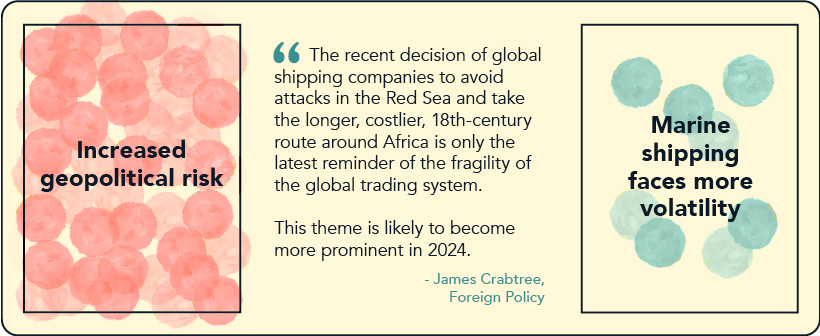
Outlooks for the Russia-Ukraine and Israel-Hamas wars are equally indecisive, with few to no experts foreseeing true resolutions for either conflict in 2024, and most citing further escalation and additional country involvement as the more likely scenarios.
Along with these ongoing geopolitical issues, 2024 is a key year for elections around the world. With the U.S., Russia, Ukraine, India, Mexico, and many other countries holding elections this year, there’s little stable ground in geopolitics without the potential for seismic shifts this year.
Further Boom or Regulatory Bust for AI in 2024?
After its breakout year in 2023, artificial intelligence faces new challenges in 2024 which is set to be another pivotal year for the technology.
While advances in the technology are inevitable, the less exciting reality of regulation and legal disputes around training data is already a key issue, as seen in the New York Times’ lawsuit against OpenAI. Along with this, the growing potential for malicious AI use around the many global elections this year could spur further calls for greater regulation.

Experts see these topics acting as a bit of a damper on another potentially explosive year for AI product growth and distribution. Many are expecting the EU to clamp down faster and harder than the U.S. when it comes to regulation.
2024 Forecasts: Everything is Connected
While the global economy, markets, geopolitics, and technological advancements have always affected each other in various ways, in 2024 these connections feel stronger than ever.
One such example is how escalating conflicts in the Middle East are affecting shipping insurance costs and routes, which could drive up inflation again and lead central banks to hold off on cutting interest rates this year, thus affecting myriad economic factors and markets around the world.
2024 feels full of both good and bad interconnected possibilities, from forecasts around AI advancements ushering in a new bull market and golden age of productivity to the potential job disruptions it could cause that our labor markets and society might not be ready for.
Despite the world growing more polarized and geopolitically fractured in the past couple of years, these predictions and forecasts remind us of how deeply dependent the health and future of the global economy is on the interconnected nature of these factors.
Markets
Top 10 Countries Most in Debt to the IMF
Argentina tops the ranking, with a debt equivalent to 5.3% of the country’s GDP.
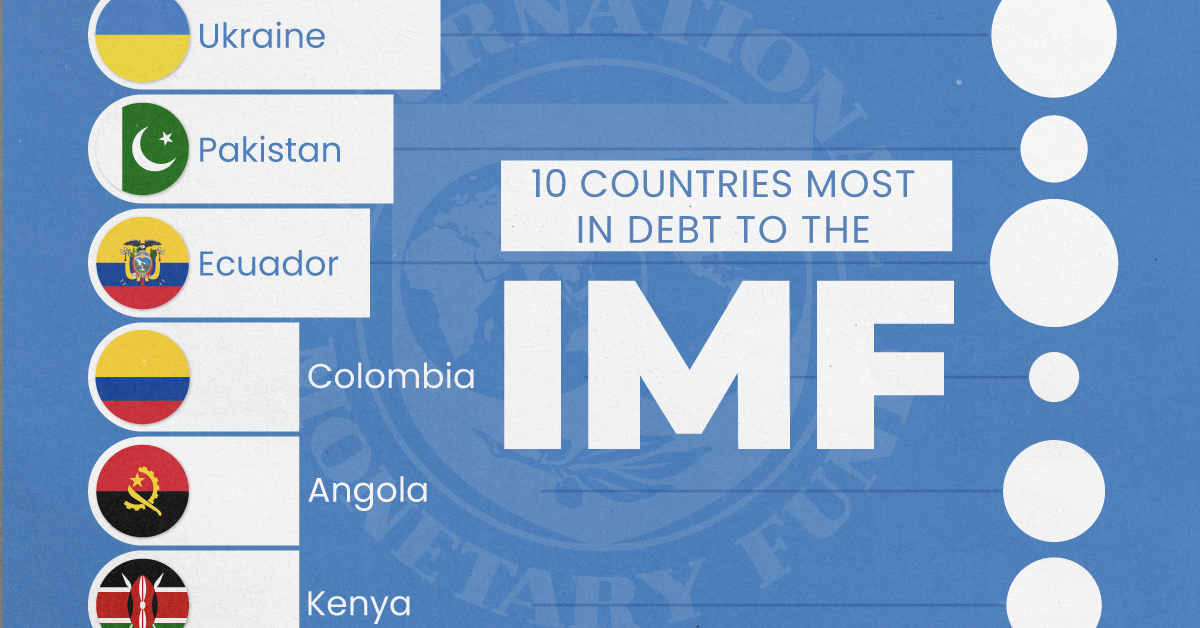
Top 10 Countries Most in Debt to the IMF
This was originally posted on our Voronoi app. Download the app for free on iOS or Android and discover incredible data-driven charts from a variety of trusted sources.
Established in 1944, the International Monetary Fund (IMF) supports countries’ economic growth by providing financial aid and guidance on policies to enhance stability, productivity, and job opportunities.
Countries seek loans from the IMF to address economic crises, stabilize their currencies, implement structural reforms, and alleviate balance of payments difficulties.
In this graphic, we visualize the 10 countries most indebted to the fund.
Methodology
We compiled this ranking using the International Monetary Fund’s data on Total IMF Credit Outstanding. We selected the latest debt data for each country, accurate as of April 29, 2024.
Argentina Tops the Rank
Argentina’s debt to the IMF is equivalent to 5.3% of the country’s GDP. In total, the country owns more than $32 billion.
| Country | IMF Credit Outstanding ($B) | GDP ($B, 2024) | IMF Debt as % of GDP |
|---|---|---|---|
| 🇦🇷 Argentina | 32 | 604.3 | 5.3 |
| 🇪🇬 Egypt | 11 | 347.6 | 3.1 |
| 🇺🇦 Ukraine | 9 | 188.9 | 4.7 |
| 🇵🇰 Pakistan | 7 | 374.7 | 1.8 |
| 🇪🇨 Ecuador | 6 | 121.6 | 4.9 |
| 🇨🇴 Colombia | 3 | 386.1 | 0.8 |
| 🇦🇴 Angola | 3 | 92.1 | 3.2 |
| 🇰🇪 Kenya | 3 | 104.0 | 2.8 |
| 🇬🇭 Ghana | 2 | 75.2 | 2.6 |
| 🇨🇮 Ivory Coast | 2 | 86.9 | 2.3 |
A G20 member and major grain exporter, the country’s history of debt trouble dates back to the late 1890s when it defaulted after contracting debts to modernize the capital, Buenos Aires. It has already been bailed out over 20 times in the last six decades by the IMF.
Five of the 10 most indebted countries are in Africa, while three are in South America.
The only European country on our list, Ukraine has relied on international support amidst the conflict with Russia. It is estimated that Russia’s full-scale invasion of the country caused the loss of a third of the country’s economy. The country owes $9 billion to the IMF.
In total, almost 100 countries owe money to the IMF, and the grand total of all of these debts is $111 billion. The above countries (top 10) account for about 69% of these debts.
-

 United States6 days ago
United States6 days agoMapped: Countries Where Recreational Cannabis is Legal
-

 Healthcare2 weeks ago
Healthcare2 weeks agoLife Expectancy by Region (1950-2050F)
-

 Markets2 weeks ago
Markets2 weeks agoThe Growth of a $1,000 Equity Investment, by Stock Market
-

 Markets2 weeks ago
Markets2 weeks agoMapped: Europe’s GDP Per Capita, by Country
-

 Money2 weeks ago
Money2 weeks agoCharted: What Frustrates Americans About the Tax System
-

 Technology2 weeks ago
Technology2 weeks agoCountries With the Highest Rates of Crypto Ownership
-

 Mining2 weeks ago
Mining2 weeks agoWhere the World’s Aluminum is Smelted, by Country
-

 Personal Finance2 weeks ago
Personal Finance2 weeks agoVisualizing the Tax Burden of Every U.S. State














